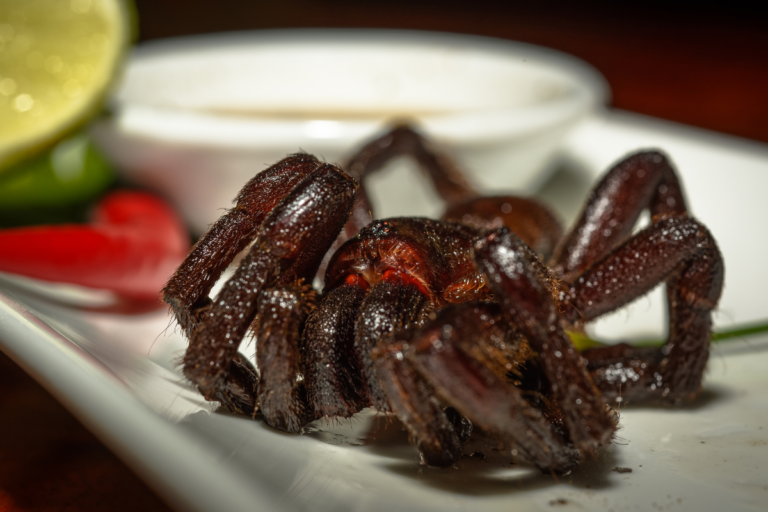Fried Tarantulas: A Special Dish, in Cambodia – When alive tarantulas are known for their nature, hairy appearance, and poisonous qualities. Surprisingly, once they are deep-fried, they transform into a delicacy enjoyed by many in Cambodia. Often coated with sugar or garlic before being sold by street vendors, these spiders are savored by both locals and daring tourists.
This culinary tradition has its origins in the times of the Khmer Rouge era—a period marked by violence and hunger. Displaced from their homes by the Khmer Rouge regime, people resorted to food sources like tarantulas for sustenance. Also, despite their nature, fried tarantulas are deemed safe to consume and offer nutrients such as high protein content, folic acid, and zinc.
Today fried tarantulas have become a budget-friendly choice for street food enthusiasts in Skuon town where they also attract curious tourists. This practice not only showcases a culinary heritage but also holds significant historical importance in Cambodian culture.

Image of a plate filled with Fried Tarantulas
Locally known as “A Ping” fried tarantulas stand out as a favored snack among Cambodians. These sizable spiders commonly inhabit the forests around Skuon. It has gained fame as one of the country’s intriguing exotic foods. The tradition of consuming tarantulas traces back to a time when food was scarce during the rule of the Khmer Rouge regime, forcing people to seek sustenance, from sources.
Throughout the years, this need evolved into a custom that has persisted until today.
Cooking Process For A Special Dish
Making tarantulas involves a series of steps to ensure they are safe and delicious to eat.
Gathering
Tarantulas are usually gathered from their homes in the wild. Hunters take care when extracting them to avoid getting bitten by their fangs.
Cleaning
The spiders undergo a cleaning process, during which their fangs are removed to reduce any venom risk.
Marination
The tarantulas are often marinated in a blend of sugar, salt, and crushed garlic. This marinade serves to enhance their flavors and impart a taste.
Deep Frying
The marinated spiders are then deep-fried until they achieve a crispy texture. This frying technique gives them a layer while keeping the insides tender.
Seasoning
Post frying, additional spices, like chili or pepper, are added to the tarantulas for a burst of flavor.
Texture
Fried tarantulas are frequently noted for their taste, which blends hints of chicken and fish. The legs offer a texture, while the body may have a delicate and slightly chewy consistency.
The belly, a blend of organs and eggs, is considered a treat, by some, with its custard-like consistency.
Cultural Importance
A survival food, it has transformed into a snack that piques the interest of both tourists and locals. In Cambodia, fried tarantulas represent more than an oddity. Also, they symbolize the resilience and adaptability of the people during challenging times. Today, these crunchy critters are available in markets and from street vendors in Skuon, known as “Spiderville.”
Nutritional Benefits
Tarantulas provide an amount of protein and essential nutrients, making them a healthy snack choice. With high protein content and low-fat levels, they offer an environmentally friendly source of nutrition.
Attraction for Tourists
Adventurous food enthusiasts and travelers often seek out fried tarantulas as part of their adventures in Cambodia. Sampling this Special Dish is considered an experience, for visitors looking to engage with local traditions.
Fried tarantulas showcase how necessity can inspire customs. Despite appearing daunting to newcomers, they shed light on Cambodia’s vibrant food scene.
Stepping out of your food choices to try this crispy treat not only offers a memorable taste adventure but also fosters a greater admiration, for the creativity and resourcefulness found in Cambodian culinary traditions.
- Crocodile Ice Cream: A Wild Adventure in Dessert-Making
- Pasta Carbonara- A Classic Italian Delight
- Japanese Miso Glazed Salmon – A Delicious Taste and Health
- Feijoada – A Taste of Brazil
- Bouillabaisse – The Legendary Fish Stew, from Marseille


